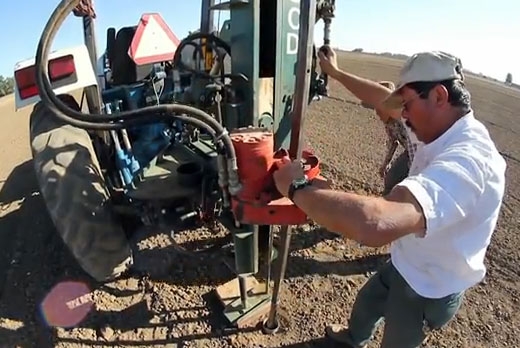Russell Ranch digs deep
Approximately every ten years, the research team at the Russell Ranch Sustainable Agriculture Facility at UC Davis gets the chance to dig deep into their research material to help answer questions about the long-term sustainability of agricultural systems.
With a steel probe attached to the back of a tractor, the team digs three meters deep to take soil samples at 432 different points around the 72-acre field. The initiative takes the team nearly a month to complete, and the information in each soil core can answer major research questions about the long-term effects of different farming methods on soil health and help inform year-round research efforts at the ranch.
“The effort that has gone into collecting this unique set of samples will pay off in figuring out agricultural impacts on processes happening not only in plain sight, but also out of view, buried deep in the soil,” said Russell Ranch director Kate Scow.
The sampling effort is part of the Century Project, Russell Ranch’s 100-year-long experiment. The project divides 72 acres of land into individual one-acre plots, with each plot given different treatments throughout the year. Some plots are irrigated; other plots are farmed without added water. Some plots are treated with compost; others are treated with synthetic fertilizer. Each individual plot demonstrates how a combination of different practices can affect crop yield, soil health and the health of surrounding ecosystems.
The 10-year sampling is a comprehensive look at the system, meant to serve as a baseline in determining the soil health at Russell Ranch. And there are a lot of factors that influence soil health. The research team tests for changes in soil organic matter, organic nitrogen, phosphorous, and other elemental content. They also test for bulk density (the amount of compaction in the soil), moisture content, and the microbial community at different soil depths.
Too, the soil sampling efforts dig deeper in the soil than much research, bringing important new information to soil science.
“Historically, much of the research has focused on the top 15 to 30 centimeters of soil. Some previous ideas about the distribution of carbon in the soil and effects of tillage on soil health have been wrong because of this,” said Scow.
With the Century Project in its 19th year, the 2012 soil samples are the third out of 11 field-wide samples to be taken over the course of the project. Changes to soil can happen slowly, so a long-term focus allows researchers to update their research as new information and new technologies become available.
“The big questions scientists are asking have changed, so we’re hoping to implement a new set of research questions that will drive us for the next 20 years,” said Emma Torbert, post-graduate fellow at Russell Ranch. “The benefit of long-term research is that we are provided the time to respond to those changing questions.”

Taking a soil sample at UC Davis' Russell Ranch.

